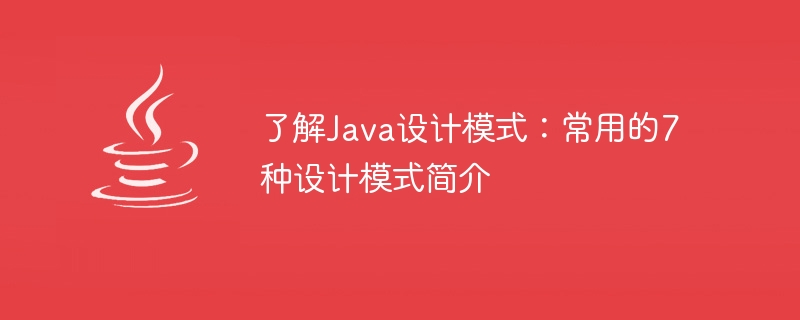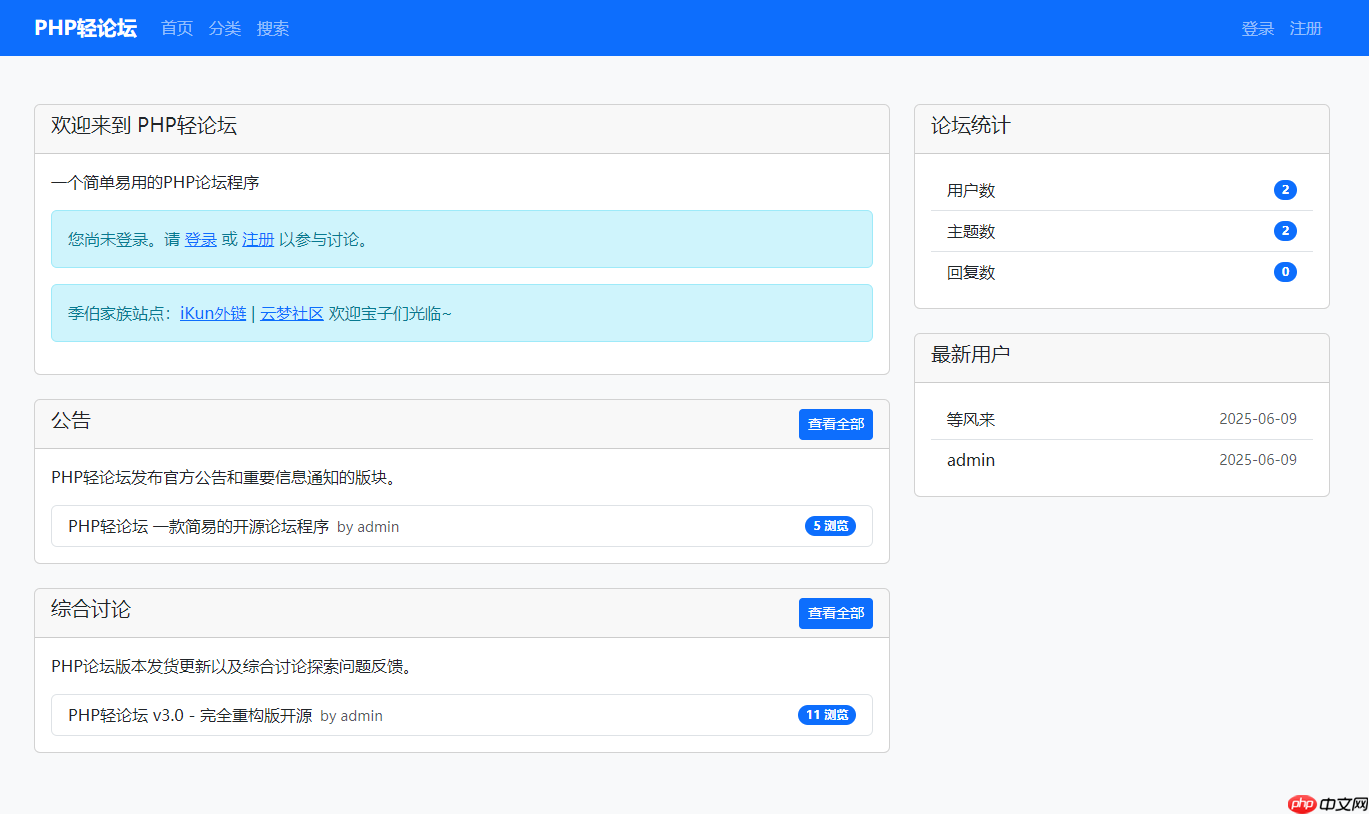
了解Java设计模式:常用的7种设计模式简介,需要具体代码示例
Java设计模式是一种解决软件设计问题的通用解决方案,它提供了一套被广泛接受的设计思想与行为准则。设计模式帮助我们更好地组织和规划代码结构,使得代码具有更好的可维护性、可读性和可扩展性。在本文中,我们将介绍Java中常用的7种设计模式,并提供相应的代码示例。

简介PHP轻论坛是一个简单易用的PHP论坛程序,适合小型社区和个人网站使用。v3.0版本是完全重构的版本,解决了之前版本中的所有已知问题,特别是MySQL保留字冲突问题。主要特点• 简单易用:简洁的界面,易于安装和使用• 响应式设计:适配各种设备,包括手机和平板• 安全可靠:避免使用MySQL保留字,防止SQL注入• 功能完善:支持分类、主题、回复、用户管理等基本功能• 易于扩展:模块化设计,便于
 21
21

public class Singleton {
private static Singleton instance;
private Singleton() {
// 私有构造函数,防止外部实例化
}
public static Singleton getInstance() {
if (instance == null) {
synchronized (Singleton.class) {
if (instance == null) {
instance = new Singleton();
}
}
}
return instance;
}
}public interface Shape {
void draw();
}
public class Circle implements Shape {
@Override
public void draw() {
System.out.println("Circle::draw()");
}
}
public class Rectangle implements Shape {
@Override
public void draw() {
System.out.println("Rectangle::draw()");
}
}
public class ShapeFactory {
public Shape getShape(String shapeType) {
if (shapeType == null) {
return null;
}
if (shapeType.equalsIgnoreCase("CIRCLE")) {
return new Circle();
} else if (shapeType.equalsIgnoreCase("RECTANGLE")) {
return new Rectangle();
}
return null;
}
}import java.util.ArrayList;
import java.util.List;
public class Subject {
private List<Observer> observers = new ArrayList<>();
private int state;
public int getState() {
return state;
}
public void setState(int state) {
this.state = state;
notifyAllObservers();
}
public void attach(Observer observer) {
observers.add(observer);
}
public void notifyAllObservers() {
for (Observer observer : observers) {
observer.update();
}
}
}
public abstract class Observer {
protected Subject subject;
public abstract void update();
}
public class BinaryObserver extends Observer {
public BinaryObserver(Subject subject) {
this.subject = subject;
this.subject.attach(this);
}
public void update() {
System.out.println("Binary String: " + Integer.toBinaryString(subject.getState()));
}
}
public class OctalObserver extends Observer {
public OctalObserver(Subject subject) {
this.subject = subject;
this.subject.attach(this);
}
public void update() {
System.out.println("Octal String: " + Integer.toOctalString(subject.getState()));
}
}
public class HexObserver extends Observer {
public HexObserver(Subject subject) {
this.subject = subject;
this.subject.attach(this);
}
public void update() {
System.out.println("Hex String: " + Integer.toHexString(subject.getState()));
}
}
public class ObserverPatternDemo {
public static void main(String[] args) {
Subject subject = new Subject();
new BinaryObserver(subject);
new OctalObserver(subject);
new HexObserver(subject);
System.out.println("First state change: 15");
subject.setState(15);
System.out.println("Second state change: 10");
subject.setState(10);
}
}public class Computer {
private String cpu;
private String memory;
private String disk;
// 省略其他属性和方法
}
public interface ComputerBuilder {
ComputerBuilder setCpu(String cpu);
ComputerBuilder setMemory(String memory);
ComputerBuilder setDisk(String disk);
Computer build();
}
public class BasicComputerBuilder implements ComputerBuilder {
private Computer computer;
public BasicComputerBuilder() {
computer = new Computer();
}
public ComputerBuilder setCpu(String cpu) {
computer.setCpu(cpu);
return this;
}
public ComputerBuilder setMemory(String memory) {
computer.setMemory(memory);
return this;
}
public ComputerBuilder setDisk(String disk) {
computer.setDisk(disk);
return this;
}
public Computer build() {
return computer;
}
}
public class Director {
private ComputerBuilder computerBuilder;
public Director(ComputerBuilder computerBuilder) {
this.computerBuilder = computerBuilder;
}
public Computer construct() {
return computerBuilder
.setCpu("i5")
.setMemory("8GB")
.setDisk("1TB")
.build();
}
}
public class BuilderPatternDemo {
public static void main(String[] args) {
ComputerBuilder computerBuilder = new BasicComputerBuilder();
Director director = new Director(computerBuilder);
Computer computer = director.construct();
System.out.println(computer.toString());
}
}public abstract class Shape implements Cloneable {
private String id;
protected String type;
abstract void draw();
public String getId() {
return id;
}
public void setId(String id) {
this.id = id;
}
public Object clone() {
Object clone = null;
try {
clone = super.clone();
} catch (CloneNotSupportedException e) {
e.printStackTrace();
}
return clone;
}
}
public class Circle extends Shape {
public Circle() {
type = "Circle";
}
public void draw() {
System.out.println("Inside Circle::draw() method.");
}
}
public class Rectangle extends Shape {
public Rectangle() {
type = "Rectangle";
}
public void draw() {
System.out.println("Inside Rectangle::draw() method.");
}
}
public class ShapeCache {
private static Map<String, Shape> shapeMap = new HashMap<>();
public static Shape getShape(String shapeId) {
Shape cachedShape = shapeMap.get(shapeId);
return (Shape) cachedShape.clone();
}
public static void loadCache() {
Circle circle = new Circle();
circle.setId("1");
shapeMap.put(circle.getId(), circle);
Rectangle rectangle = new Rectangle();
rectangle.setId("2");
shapeMap.put(rectangle.getId(), rectangle);
}
}
public class PrototypePatternDemo {
public static void main(String[] args) {
ShapeCache.loadCache();
Shape clonedShape1 = ShapeCache.getShape("1");
System.out.println("Shape: " + clonedShape1.getType());
Shape clonedShape2 = ShapeCache.getShape("2");
System.out.println("Shape: " + clonedShape2.getType());
}
}public interface MediaPlayer {
void play(String audioType, String fileName);
}
public interface AdvancedMediaPlayer {
void playVlc(String fileName);
void playMp4(String fileName);
}
public class VlcPlayer implements AdvancedMediaPlayer {
public void playVlc(String fileName) {
System.out.println("Playing vlc file. Name: " + fileName);
}
public void playMp4(String fileName) {
// 空实现
}
}
public class Mp4Player implements AdvancedMediaPlayer {
public void playVlc(String fileName) {
// 空实现
}
public void playMp4(String fileName) {
System.out.println("Playing mp4 file. Name: " + fileName);
}
}
public class MediaAdapter implements MediaPlayer {
AdvancedMediaPlayer advancedMediaPlayer;
public MediaAdapter(String audioType) {
if (audioType.equalsIgnoreCase("vlc")) {
advancedMediaPlayer = new VlcPlayer();
} else if (audioType.equalsIgnoreCase("mp4")) {
advancedMediaPlayer = new Mp4Player();
}
}
public void play(String audioType, String fileName) {
if (audioType.equalsIgnoreCase("vlc")) {
advancedMediaPlayer.playVlc(fileName);
} else if (audioType.equalsIgnoreCase("mp4")) {
advancedMediaPlayer.playMp4(fileName);
}
}
}
public class AudioPlayer implements MediaPlayer {
MediaAdapter mediaAdapter;
public void play(String audioType, String fileName) {
if (audioType.equalsIgnoreCase("mp3")) {
System.out.println("Playing mp3 file. Name: " + fileName);
} else if (audioType.equalsIgnoreCase("vlc") || audioType.equalsIgnoreCase("mp4")) {
mediaAdapter = new MediaAdapter(audioType);
mediaAdapter.play(audioType, fileName);
} else {
System.out.println("Invalid media. " + audioType + " format not supported");
}
}
}
public class AdapterPatternDemo {
public static void main(String[] args) {
AudioPlayer audioPlayer = new AudioPlayer();
audioPlayer.play("mp3", "beyond_the_horizon.mp3");
audioPlayer.play("mp4", "alone.mp4");
audioPlayer.play("vlc", "far_far_away.vlc");
audioPlayer.play("avi", "mind_me.avi");
}
}public interface Strategy {
int doOperation(int num1, int num2);
}
public class OperationAdd implements Strategy {
public int doOperation(int num1, int num2) {
return num1 + num2;
}
}
public class OperationSubtract implements Strategy {
public int doOperation(int num1, int num2) {
return num1 - num2;
}
}
public class OperationMultiply implements Strategy {
public int doOperation(int num1, int num2) {
return num1 * num2;
}
}
public class Context {
private Strategy strategy;
public Context(Strategy strategy) {
this.strategy = strategy;
}
public int executeStrategy(int num1, int num2) {
return strategy.doOperation(num1, num2);
}
}
public class StrategyPatternDemo {
public static void main(String[] args) {
Context context = new Context(new OperationAdd());
System.out.println("10 + 5 = " + context.executeStrategy(10, 5));
context = new Context(new OperationSubtract());
System.out.println("10 - 5 = " + context.executeStrategy(10, 5));
context = new Context(new OperationMultiply());
System.out.println("10 * 5 = " + context.executeStrategy(10, 5));
}
}通过以上示例代码,我们对Java中常用的7种设计模式进行了简单的介绍。每一种设计模式都有不同的场景和应用,它们可以在不同的项目中发挥作用。希望这篇文章可以帮助你了解并应用设计模式,并提升你的代码质量和开发效率。
以上就是深入了解常用的7种Java设计模式的详细内容,更多请关注php中文网其它相关文章!

java怎么学习?java怎么入门?java在哪学?java怎么学才快?不用担心,这里为大家提供了java速学教程(入门到精通),有需要的小伙伴保存下载就能学习啦!

Copyright 2014-2025 https://www.php.cn/ All Rights Reserved | php.cn | 湘ICP备2023035733号